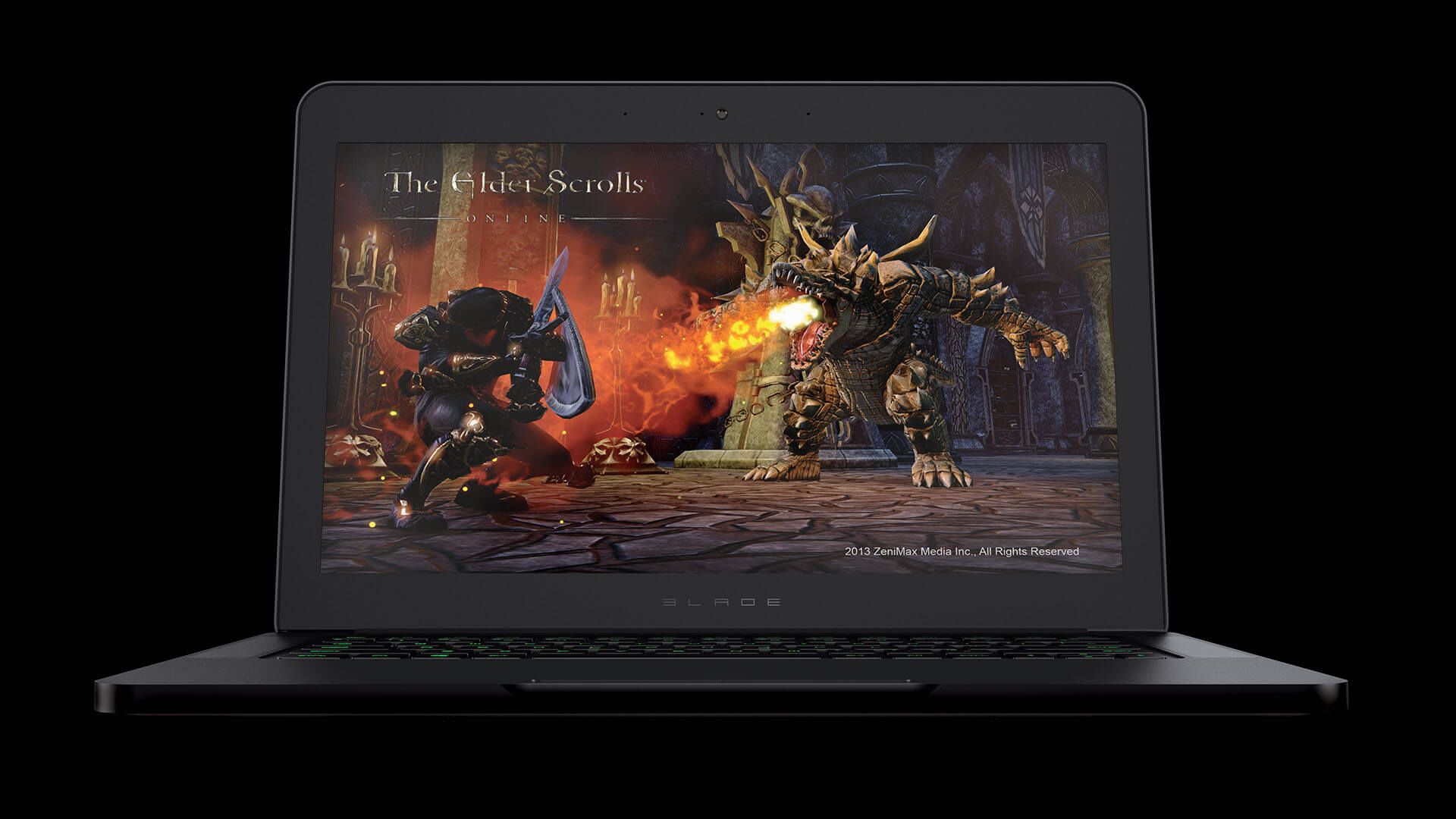[HTML1]
Razer's "for gamers, by gamers" attitude has certainly brought them a long way since their start in the late 1990s, catering to the hardcore gaming crowd and pitching them the high-end peripherals necessary to achieve super-leet dominance. Their first venture into gaming devices was only two short years ago, when the Switchblade made its debut at the 2011 Consumer Electronics Show. After walking away with a People's Voice award and continuing to develop its consumer electronics branch, Razer returned later that year with the Blade — touted as the world's first "true gaming laptop."
At a staggering price of $2,800, the original Blade laptop was a promising, yet pricey, piece of hardware. While the technology inside was solid, the price point was simply out of reach for most consumers. Today, the small but powerful computer peripheral manufacturer has stepped back into the spotlight to show off its 2013 update of the Blade laptop line, with an all new, ultra-thin 14" screen.
Weighing in at roughly 4 pounds and less than 3/4 of an inch thick, the 14" Razer Blade gaming laptop is just barely thinner than the current generation MacBook Air, albeit about 25% heavier. Packed inside this small frame is a technological powerhouse: 4th generation Intel Core processor; 8 GB of DDR3 RAM; and the Nvidia GeForce GTX 765M which boasts 2GB of dedicated video memory. At a starting price of $1,799, the Razer Blade still isn't cheap, but it's a huge leap forward.
The standard 17" model is also available, boasting similar hardware but adding the Switchblade User Interface, a touch surface used for navigation, quick access to applications, and much more. It's as thin as the 14" model (0.66 inches to be precise) and weighs about 6.5 pounds, which is still considerably better than many desktop replacement laptops currently available.
[gallery columns="2" orderby="title"]
Those concerned with battery life can rest easy, as Razer promises up to 6 hours of use time on a single charge. How this will fare in real-world testing remains to be seen, as does the issue of system temperature. After all, this kind of power is going to require an impressive cooling system in order to function efficiently as a portable game-centric PC.
As for the rest of the system specifications, they are as follows:
- Future 4th gen Intel® Core&tradel processor (formerly codename ´Haswell´)
- 8 GB Onboard Memory (DDR3L - 1600 MHz)
- NVIDIA® GeForce® GTX 765M (2 GB GDDR5) & Intel HD4600
- Windows® 8 64 Bit
- 128 GB SSD, with optional 256/512 GB SSD (mSATA)
- Qualcomm® Killerâ„¢ NIC N1202 (802.11a/b/g/n + Bluetooth® 4.0)
- 14.0 in. HD+ 16:9 Ratio, 1600 x 900, with LED backlight
- Built-in stereo speakers
- 3.5 mm audio microphone/headphone combo jack
- Array microphone
- (3x) USB 3.0 port (SuperSpeed)
- HDMI 1.4a audio and video output
- Dolby® Home Theater® v4
- 7.1 Codec support (via HDMI)
- Built-in full HD webcam (1.3 MP)
- Compact 150 W Power Adapter
- Built-in 70 Wh Rechargeable lithium ion polymer battery
- Razerâ„¢ Anti-Ghosting Keyboard (with adjustable backlight)
- Razerâ„¢ Synapse 2.0 Enabled
- Kensington Lock
- 13.6 in. / 345 mm (Width) x 0.66 in. / 16.8 mm (Height) x 9.3 in. / 235 mm (Depth)
- 4.135 lbs. / 1.876 kg
With this kind of hardware, there's no doubt that the 14" Razer Blade packs a punch, and at a much more affordable price than its predecessors at that. The base 128GB SSD version clocks in at $1,799, while the 256 and 512GB versions are $1999 and $2299 respectively. The 17" version features similar hardware and will set buyers back $2,299 for the base model, $2499 for 256GB and $2799 for 512GB. Very pricey stuff, indeed.
The specs for the standard 17" flavor are as follows:
- Future 4th gen Intel® Coreâ„¢ processor (formerly codename ‘Haswell’)
- 8 GB DDR3L (2 x 4 GB 1600MHz)
- NVIDIA® GeForce® GTX 765M (2 GB GDDR5) & Intel HD4600
- Windows 8 64 Bit
- 128 GB SSD, with optional 256/512 GB SSD (mSATA)
- Qualcomm® Killerâ„¢ NIC N1202 (802.11a/b/g/n + Bluetooth® 4.0)
- 17.3-in. Full HD 16:9 Ratio, 1920 x 1080, with LED backlight
- Stereo 2.0 speakers
- 3.5 mm audio microphone/headphone combo jack
- HD Webcam (front-facing, 2.0 MP)
- Array microphones
- (3x) USB 3.0 port (SuperSpeed)
- Codec supports 7.1 (via HDMI 1.4)
- Dolby® Home Theater® v4
- Razerâ„¢ Anti-Ghosting Keyboard (with adjustable backlight)
- Razerâ„¢ Switchblade User Interface
- Razerâ„¢ Synapse 2.0 Enabled
- Built-in 74 Wh Rechargeable lithium ion polymer battery
- Kensington Lock
- 16.8 in. / 427 mm (Width) x 0.88 in. / 22.4 mm (Height) x 10.9 in. / 277 mm (Depth)
- 6.58 lbs. / 2.98 kg
What's your verdict, Ranters? Is this the next evolutionary step of not only gaming laptops, but Windows-based portable systems on the whole? Or is Razer spreading itself too thin by attempting to wedge into a niche market already dominated by MacBooks and Intel-powered ultrabooks?
The 2013 Razer Blade laptop will be available for pre-order beginning June 3rd.
-
Follow me on Twitter @superkyol.

